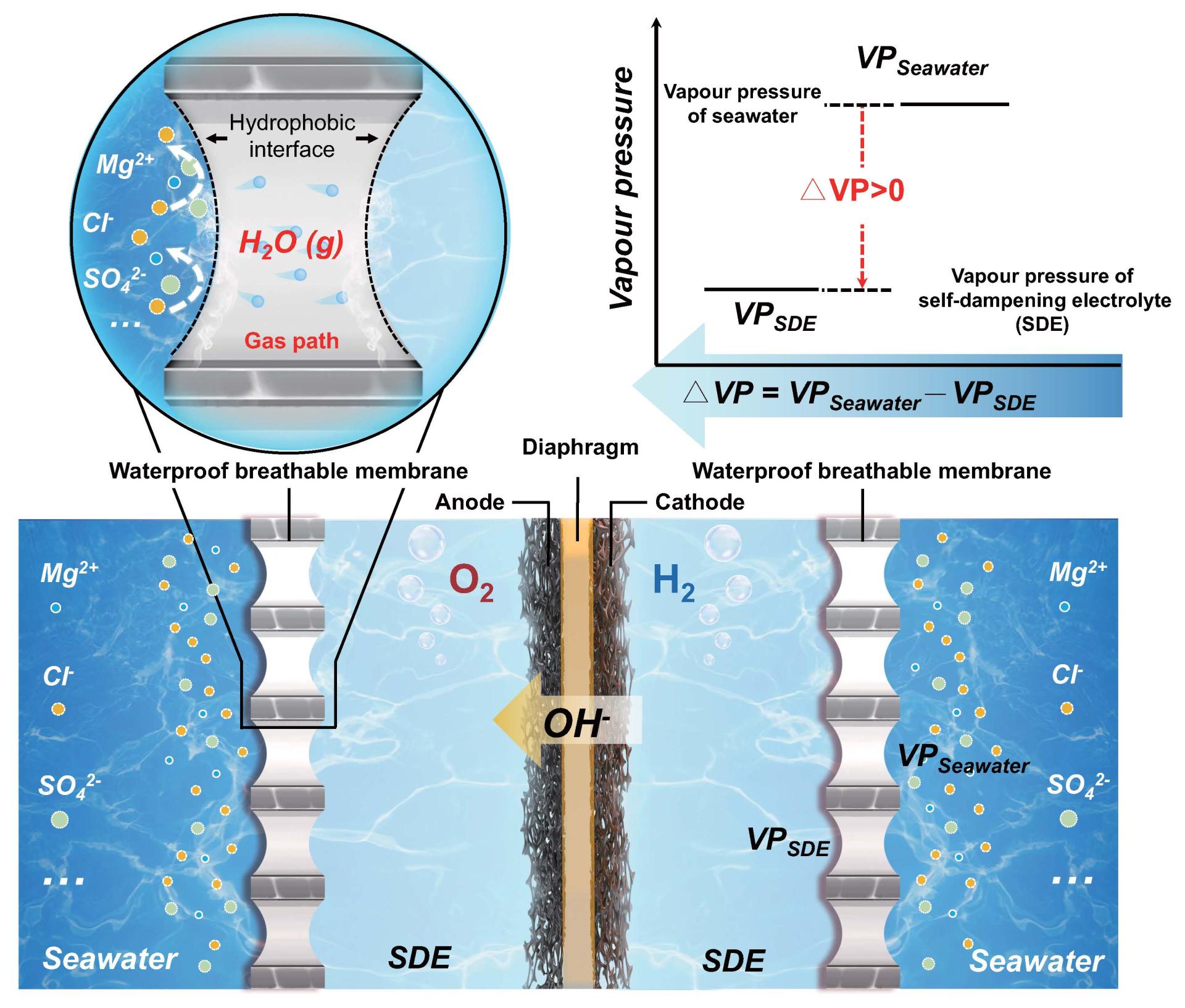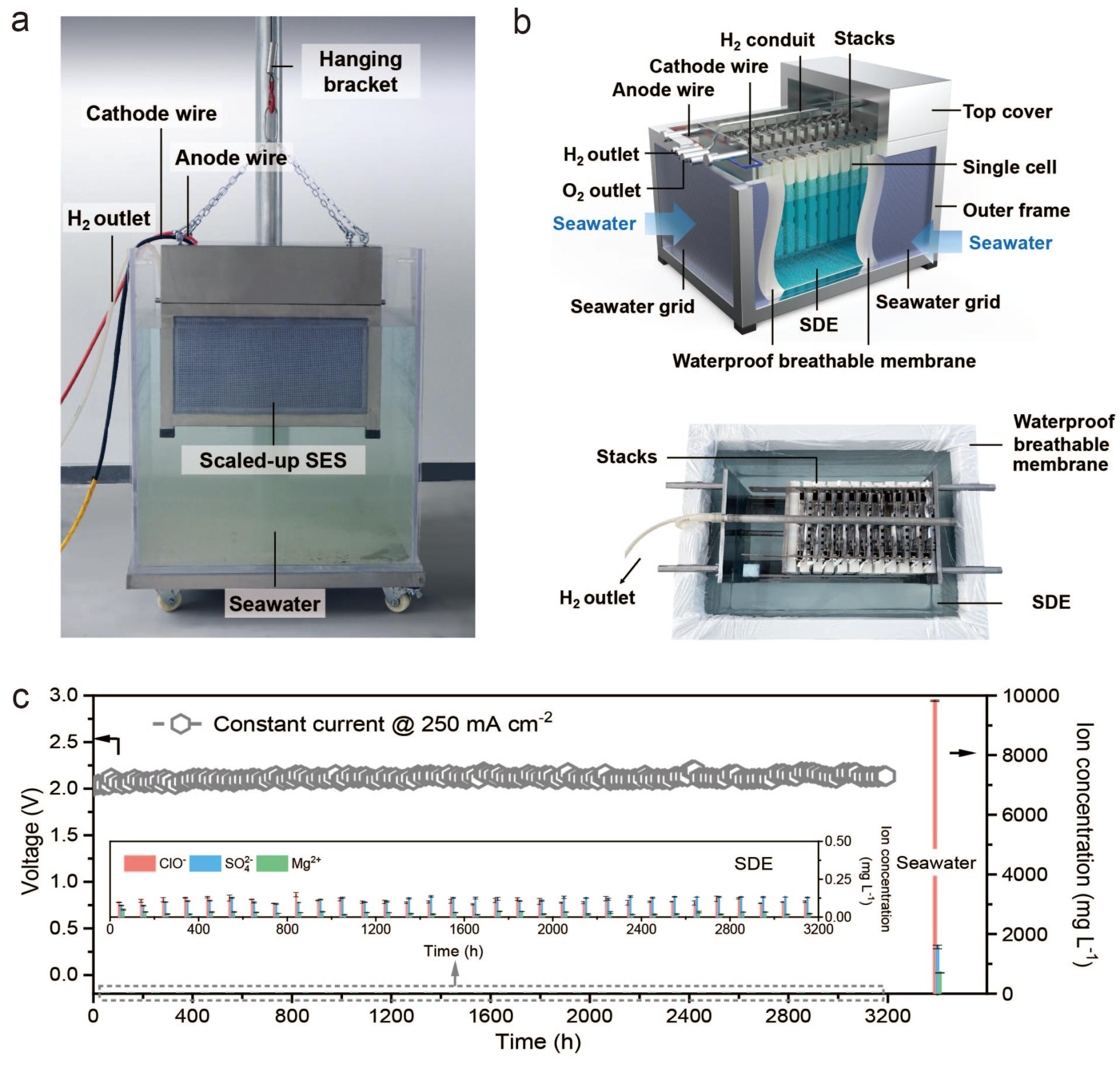On November 30, 2022, Academician Xie Heping and his research team from Shenzhen University/Sichuan University, with Shenzhen University as the first completing institution, published their research results in Nature entitled "A membrane-based seawater electrolyser for hydrogen generation" in Nature. The research has established a new principle and technology for in-situ direct electrolysis of hydrogen generation without desalination driven by phase change migration from the combination of physical mechanics and electrochemistry for the first time, and has achieved a breakthrough in efficient in-situ direct electrolysis of hydrogen generation from seawater without desalination process, side reactions and additional energy consumption (i.e., using seawater as pure water and producing hydrogen directly in-situ by electrolysis in seawater). It has solved the problem of direct electrolytic hydrogen production from seawater for half a century, and is expected to form a global new strategic industry of "marine green hydrogen", which is original to China! As the Nature reviewer commented, "Few papers have been able to convincingly achieve stable hydrogen production from seawater on a large scale, but this paper has done exactly that. They have perfectly solved the long-standing problem of harmful corrosiveness that has plagued the field of seawater hydrogen production, and will open the door to low-cost fuel production that promises to drive change toward a more sustainable world!"
Green zero-carbon hydrogen energy is an important direction for future energy development, and with the explosive growth of hydrogen energy, it is expected that China's annual demand for hydrogen will reach 130 million tons by 2060, requiring the consumption of about 1.17 billion tons of pure water for electrolysis each year at that time. However, the shortage of fresh water resources will seriously restrict the development of "green hydrogen" technology. The ocean is the largest hydrogen mine on earth, and asking for water from the sea is an important direction for the future development of hydrogen energy! However, the complex composition of seawater (about 92 chemical elements) leads to many problems and challenges in the production of hydrogen from seawater. Desalination followed by hydrogen production is the most mature technology path for hydrogen production from seawater, and it has been carried out in many countries around the world as a large-scale demonstration project. However, such technology relies heavily on large-scale desalination equipment, and the process is complicated and takes up a lot of land resources, further pushing up the cost of hydrogen production and the difficulty of engineering construction. In the early 1970s, some scientists asked whether seawater could be directly electrolyzed to produce hydrogen. Over the past half century, famous research teams at home and abroad, such as Stanford University, CNRS, University of Adelaide, Chinese Academy of Sciences, etc., have conducted a lot of research through catalyst engineering and membrane material science, aiming at solving the problems of chlorine precipitation, calcium and magnesium precipitation, catalyst deactivation, etc. in the direct electrolysis of seawater for hydrogen production. However, so far, there is no breakthrough theory and principle to completely avoid the influence of complex components of seawater on the electrolysis of hydrogen production, and the principle and technology of efficient and stable direct electrolysis of seawater for large-scale hydrogen production is still a gap in the world.
Academician Xie Heping proposed a new idea of combining physical mechanics and electrochemistry to solve the challenges of direct electrolytic hydrogen production from seawater, and thus creatively created a new principle and technology of direct electrolytic hydrogen production from seawater without desalination in situ. By skillfully combining physical mechanics processes such as molecular diffusion and interfacial phase equilibrium with electrochemical reactions, the theoretical model of direct electrolytic hydrogen production from seawater driven by phase change migration was established, and the mechanism of interfacial pressure difference on spontaneous phase change mass transfer from seawater under the micron-level air gap pathway was revealed, forming a dynamic self-regulating stable electrolytic hydrogen production method with electrochemical reactions and seawater migration, and solving the half-century-old problem of harmful corrosiveness that plagues the field of seawater electrolysis. It has solved the half-century-old problem of harmful corrosion in the field of hydrogen production (patents applied for: CN2021110197054;CN114481164A;CN2022110704439;CN2022110748884;PCT/CN2022/128225). At the same time, the world's first 400L/h seawater direct in-situ electrolytic hydrogen production technology and equipment was developed, which has been operating continuously in Shenzhen Bay seawater for over 3200 hours, convincingly realizing a stable and large-scale hydrogen production process from seawater! In addition, acidic and alkaline solid gel electrolytes were further developed to show that the phase change migration strategy is adapted to different electrolyte materials and is expected to accompany the iterative development of PEM and AEM electrolysis technologies. Meanwhile, the principle technology can be explored to be extended to diversified water resources (e.g. river water, wastewater, salt lake, etc.) for direct in-situ hydrogen production, providing a new idea of multi-effective utilization for resource enrichment concentration and energy production. As the Nature reviewer highly praised the research, "This work provides an attractive strategy to use non-potable water for sustainable fuel production in society and ecology, which I think is a major breakthrough!"
The "direct in-situ electrolytic hydrogen production from seawater without desalination" is a multidisciplinary theory, an original principle and technological breakthrough developed independently by China, and opens up a brand new path for global hydrogen production from seawater; this technology can integrate "offshore wind power and other renewable energy utilization - seawater resource utilization - hydrogen energy production It is expected to form a new model of in-situ direct electrolysis of seawater for hydrogen production without desalination, additional catalyst engineering, seawater transportation and pollution treatment, which can truly transform inexhaustible "seawater resources" into "seawater energy". "This technology can be used in the future to build a new model of in situ direct electrolysis of hydrogen production, which can transform the inexhaustible seawater resources into seawater energy. This technology can build an integrated in-situ seawater hydrogen production plant combined with offshore renewable energy in the future, which is expected to be the key to the large-scale development of renewable power in deep and distant seas, and accelerate the formation of China's original "ocean green hydrogen" global emerging strategic industry with multi-energy complementarity!
Direct link to the paper:
https://doi.org/10.1038/s41586-022-05379-5

Principle of in situ direct electrolytic hydrogen production from seawater without desalination driven by phase change migration

In-situ direct electrolysis of seawater without desalination to produce hydrogen in scale technology equipment and stability